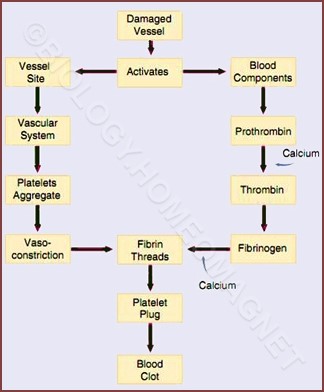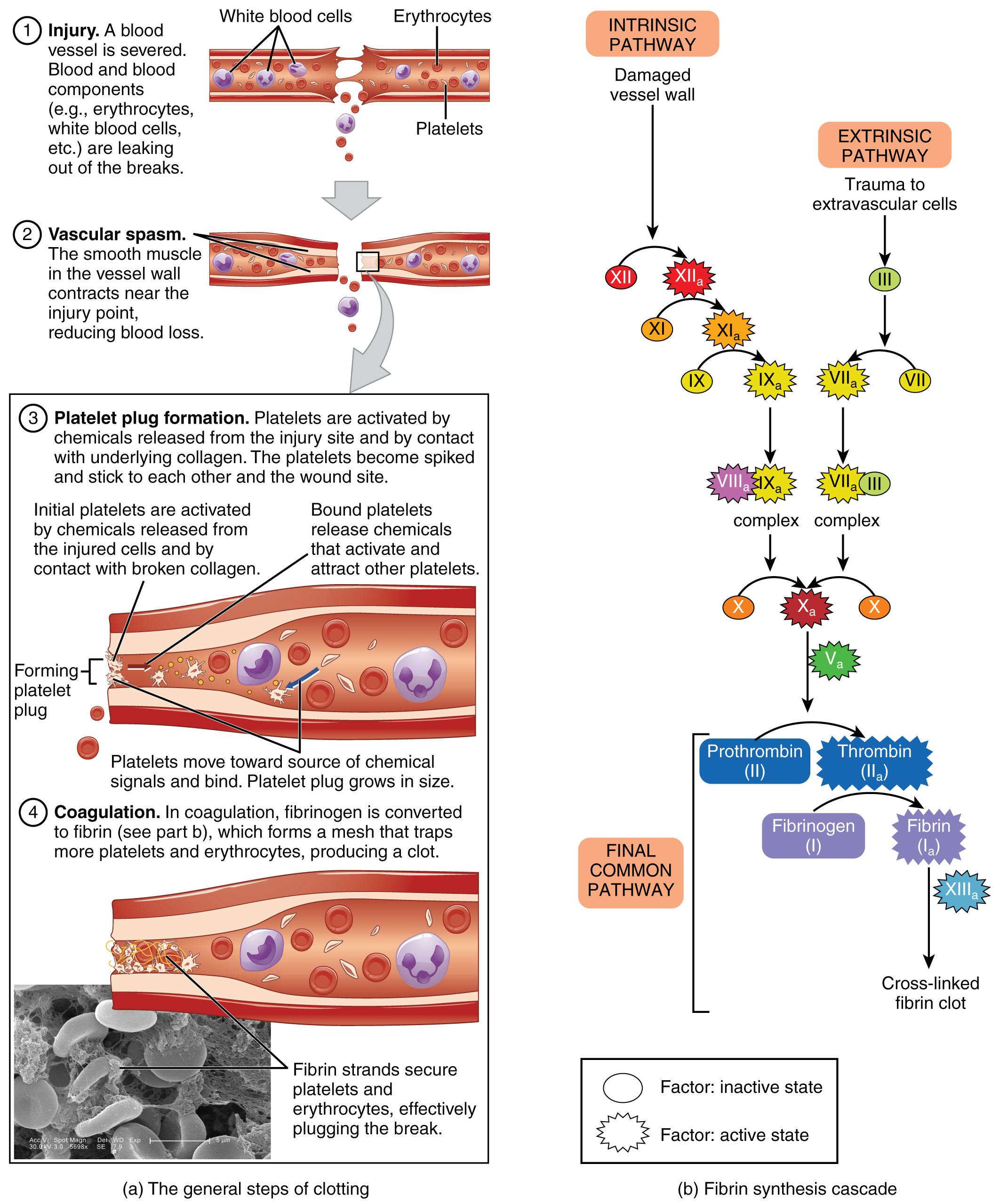Describe the Process of Blood Clotting in Human Beings
To control blood loss the blood vessel immediately narrows called constriction which limits. - i Formation of thromboplastin ii Formation of thrombin from prothrombin iii Formation of fibrin from fibrinogen.

Blood Clotting Process Biology For Everybody
Blood coagulation has been described in both monotremes.

. Fibrin is formed by the conversion of inactive fibrinogens in the plasma by the enzyme thrombin. The entire process is divided here into three major steps. These platelets are involved in blood clotting and scab forming.
- When blood vessels are damaged blood comes out and platelets are exposed to air and they rupture on the damaged tissue. Proteins in your blood called clotting factors signal each other to cause a rapid chain reaction. Platelets a type of blood cell and proteins in your plasma the liquid part of blood work together to stop the bleeding by forming a clot over the injury.
An enzyme that activates the conversion of prothrombin. Release an enzyme called thrombokinase or thromboplastin. Known as blood coagulation.
They also interact with other blood proteins to form fibrin. Formation of factor X and prothrombinase. Vitamin KJ phylloquinone.
In the presence of calcium ions. Is needed for the formation of prothrombin. Typically your body will naturally dissolve the blood clot after the injury has healed.
It potentially results in hemostasis. Clotting of the blood occurs only when thrombin converts fibrinogen to fibrin clot. Next the platelets play a key role in covering the injured area to stop the bleeding.
Blood contains tiny fragments of cells called platelets. They release thrombokinasethromboplastin. Learn vocabulary terms and more with flashcards games and other study tools.
It ends with a dissolved substance in your blood turning into long strands of fibrin. The immediate process of stopping bleeding after injury is known as hemostasis and involves three events which are. The mechanism of coagulation involves activation adhesion and aggregation of platelets along with deposition and maturation of fibrin.
Thrombin converts soluble blood protein. Describe the three phases of the normal blood-clotting process. A platelet plug is formed and the external bleeding stops.
Stages of Blood Clotting. Blood clotting or coagulation is an important process that prevents excessive bleeding when a blood vessel is injured. Blood vessel spasm the formation of the platelet plug and the blood clot formation process.
An enzyme that activates the conversion of prothrombin. Hemostasis is the bodys way of stopping bleeding on injured vessels. Blood coagulation is the process whereby cells and soluble protein elements interact to form an intravascular blood clot.
Blood clotting is the process by which elements of the blood combine to form a thick gel-like substance that prevents one from excessive bleeding. The table below shows the percentage concentration of certain substances in blood plasma glomerular filtrate and urine in a human being at a particular time. Thrombokinase is an enzyme that initiates the process of blood clotting by neutralizing anticlotting or anti-coagulant factor called heparin.
After the formation of clot the clot retracts and a straw colored fluid called serum is separated. The primary hemostasis involves the process of vasoconstriction which response to the injury of the body in the. This blood clotting is a complex process involving many clotting factors incl.
When a blood vessel is cutinjured plateletsthrombocytesdamaged tissuewound is exposed to the air. Next small molecules called clotting factors cause strands of blood-borne materials called fibrin to stick. In the intrinsic pathway the collagen of the damaged blood vessel initiates a string of reactions that activates factor X.
A Explain the likely impact on the composition of urine in case of the following. The blood clotting process includes three main following phases. Blood clotting normally occurs when there is damage to a blood vessel.
Coagulation also known as clotting is the process by which blood changes from a liquid to a gel forming a blood clot. The human body organ system is consisting of 11 major body organ systems that are involved in the. Blood clotting is also referred to as blood coagulation.
They change shape from round to spiny stick to the broken vessel wall and each other and begin to plug the break. A cut on the skin or an internal injury creates a small tear in a blood vessel wall which causes blood flow. In the presence of calcium ions.
I Vigorous physical exercises ii A meal rich in proteins b Name the process responsible for. The platelets and the protein in the plasma play a key role in aiding the coagulation of blood. Vitamin K phylloquinone.
When an injury causes a blood vessel wall to break platelets are activated. Start studying Blood Clotting Process. Blood clotting technically blood coagulation is the process by which liquid blood is transformed into a solid state.
When a blood vessel is cutinjured plateletsthrombocytesdamaged tissuewound is exposed to the air. Prothrombinase can form either inside the blood vessels intrinsically or outside the blood vessels extrinsically. Thus the serum is blood minus the clot.
The other being the heart and the blood. Calcium ions enzymes platelets damaged tissues activating each other. Describe the antigens associated with the blood types of the ABO blood group.
They also activate a. The plasma protein fibrinogen is converted into a non-globular and insoluble protein called fibrin. When this occurs in response to vessel injury it is an important protective mechanism that functions to seal vascular bleeds thereby prevent excessive hemorrhage.
Is needed for the formation of prothrombin. They release thrombokinasethromboplastin. The blood clotting process or coagulation is an important process that prevents excessive building in case the blood vessel becomes injured.
When skin is wounded platelets are able to. Heres how the process works. The coagulation process can be described in three major steps.
Platelets immediately begin to adhere to the cut edges of the vessel and release chemicals to attract even more platelets. Thrombin converts soluble blood protein fibrinogen. Coagulation is the process of forming a blood clot.
The process of Blood Coagulation has three main stages namely Hemostasis or the formation of a gel-like substance at the site of injury to prevent further loss of Blood from taking place thrombus formation as a result of platelets aggregation and the conversion of fibrinogen to fibrin and clot retraction which is the contraction of the wound by smooth muscles to draw the edges.

Hemostasis Anatomy And Physiology

Describe In Brief The Process Of Blood Clotting

Platelets Help In Clotting Of Blood At Injured Side Draw A Flow Diagram Of This Process Biology Topperlearning Com 1wx1d9ff

No comments for "Describe the Process of Blood Clotting in Human Beings"
Post a Comment